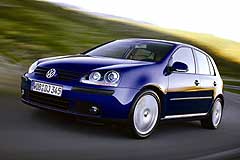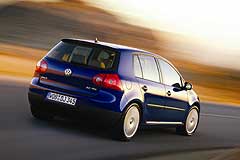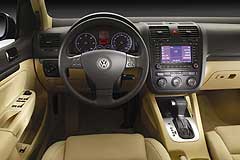
The Golf, the most successful German automobile ever, with over 22 million units built so far, debuts in the autumn of 2003 in its fifth generation. The design and technology of the Golf, which is available in two and four-door models, are more confident and dynamic than ever before, and represent, therefore, the largest evolutionary step since the model series came into being. Even at first glance, the newcomer can unmistakably be recognised as the original in its class - as the Golf. The design, however, with its characteristic C-pillar, the powerfully-built body rear end, the pronounced sporting character of the body front end and the muscular, rakish silhouette displays confident, new dynamics.
This plus in terms of dynamics also applies unreservedly to the technical features of the Golf. The safety chassis (including ESP) with its newly developed multilink rear suspension and the optimised front suspension-strut-type axle, the new electromechanical steering system, the efficient direct injection technology (FSI and TDI engines), the advanced five and six speed manual gearboxes or the six-speed automatic transmission (converter transmission and direct shift gearbox "DSG"), which is unmatched by the competition in this segment, reflect the innovative approach that has been taken.
At market launch the new Golf will be available with two petrol engines (1.4 with 55 kW / 75 bhp and 1.6 FSI with 85 kW / 115 bhp) as well as two TDI engines (1.9 TDI with 77 kW / 105 bhp and 2.0 TDI with 103 kW / 140 bhp). All engines meet the EU 4 standard. Four more engines will be available shortly after: two FSI engines (1.4 FSI with 66 kW / 90 bhp and 2.0 FSI with 110 kW / 150 bhp), a 1.6-litre engine with 75 kW / 102 bhp and a diesel direct injection unit (2.0 SDI with 55 kW / 75 bhp). The sporty top-of-the-range engines will be introduced in a third phase.
In addition to the drive train and chassis, the fifth generation Golf features an array of further technical innovations. They include, for the first time worldwide in a volume production vehicle, modular doors which can be repaired inexpensively if they are damaged, the almost completely draught-free automatic air conditioner (Climatronic) with automatic air recirculation function when reversing and ventilation cut-off while the windscreen washer system is being activated, the electrical 4-way lumbar support (integrated in the electric seat) which is featured in this class for the first time, an optional folding front passenger seat backrest and the auxiliary heater available ex works.

The design and technology have been complemented by the element of space to again create an impressive package of unique Golf features. Since the body is wider (1,759 mm / + 24 mm), higher (1,483 mm / + 39 mm) and longer (4,204 mm / + 55 mm), it is much more spacious (+ 54 mm cabin length), particularly in the rear compartment (+ 55 mm legroom / + 24 mm headroom at the rear and + 8 mm at the front) and luggage space (350 litres / + 20 litres). This clear plus closes the gap to the next higher class. In respect of safety and quality, the new Golf has already eliminated this gap completely. Example: with an increase in static body rigidity of 80 percent, the Golf achieves a standard that is unmatched by the competition.
The best Golf ever therefore has all the ingredients to continue in the successful footsteps of its predecessor. According to the current planning, 135,000 units of the new generation Golf will be produced in the fourth quarter of 2003. Sales of Germany's most important car are expected to exceed 600,000 units from 2004 - the first full sales year.
Not least because of this, the new Golf is also a key factor for the attractiveness of Germanyas a production location. Should Wolfsburg, home to Volkswagen AG and the world's largest automobile production plant, be referred to as "Golfsburg" in the headlines during the launch phase of the new model from August 25 until October 10, this is not so much a marketing idea as a reflection of the city fathers' gratitude. For the Golf is the main economic engine in this city. At the parent plant in Wolfsburg, approximately 20,000 employees are directly involved in the production, development and distribution of the best-selling model. 100 components suppliers and businesses of every description in and around Wolfsburgare indirectly involved in the production of the Golf.

The production change-over for the new generation was completed at a very early stage, thus ensuring an optimal production ramp-up. The Golf is also produced in parallel at the Mosel Volkswagen plant in Saxony. On top of that there are two international production locations for the Golf, namely the Brusselsplant in Belgiumand the Uitenhage plant in South Africa.
Irrespective of where the Golf is produced, the production process sets new standards. The proportion of high-strength body panels for example has again risen significantly. The net result is a significant plus in terms of body strength, crash safety and comfort whilst optimising weight. For example the laser-welding process: 140 special robots ensure the high body rigidity of the Golf, among other things, by means of laser-welded seams with a total length of 70 metres, as compared to five metres in the predecessor. Take quality assurance for example: as one of the last of many checks, the electronic and electrical components of each Golf are checked in the so-called "Try Out Room". The final step is a 10-minute test on the "running-in stand". After that, the rule is: the Golf runs and runs and runs and...




